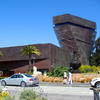More about Our Banner in the Sky
- All
- Info
- Shop

Sr. Contributor
Frederic Edwin Church’s Our Banner in the Sky is nationalistic propaganda at its finest.
April, 1861: Fort Sumter, South Carolina. Major Robert Anderson receives a letter from President Lincoln’s office that the US Army will be receiving much needed provisions for its beleaguered troops. Outside, the Confederates bristle at the news that the Union will not be vacating the Fort as anticipated. It’s with this letter that the Confederates decide if the Union won’t be starved out, they’ll have to be shot out. Thus, the first battle of the U.S. Civil War is set in motion.
In a token of civility surprising even in a civil war, Anderson was issued multiple orders from the enemy to evacuate safely, but declined them all for the sake of the Union. He was even given a one-hour final warning before the bombardment began, yet decided to quite literally stick to his guns. Despite being in a well-armed Fort, the Union forces were tired, undersupplied and outnumbered by the 6,000 Confederate troops that made their way to Charleston Harbor on April 12th, 1861. The first shots were fired by the Confederates that morning at 4:30, beginning what would be 34 hours of heavy fire. At one point Fort Sumter did catch fire, but the troops inside continued to fight with enough gusto that the impressed Confederates onshore would cheer when the Sumpter soldiers managed to shoot off any rounds.
And now we’re brought to the purpose of this history lesson: it was during the bombardment of Fort Sumter that the Confederates managed to break the flagpole holding the U.S. flag. Union troops quickly created a makeshift pole for the Stars and Stripes on the Fort’s parapet, but would soon follow it with the white flag of surrender. As the Union troops evacuated the Fort they fired a 100 gun salute using scrap to honor their now tattered but beloved flag. The salute was cut short when a Union soldier was killed, as the shots set off a spark that caused an explosion.
It’s no question that the Fort Sumter flag was great propaganda for the Union. The flag would be taken to Union rallies and even auctioned off to raise funds. I mean, what’s more inspiring than the image of soldiers raising their tired eyes to gaze upon Old Glory in honor, even in the face of defeat? Nothing, except perhaps art that takes this tattered flag and paints all the patriotic symbols you can imagine into it. This is just what Frederic Edwin Church did when he created Our Banner in the Sky.
This painting is a bit of a departure from Church’s usual grand, romantic landscapes. It’s a small allegorical piece featuring a red, white, and blue flag created out of the colors and clouds of the rising sun against a hilly landscape. The flagpole is a crooked tree trunk in the foreground, and the 33 stars of the Fort Sumter flag are represented by the stars of the retreating night sky peeking through the clouds. Amongst these stars is a vivid North Star, representing, no surprise, the North. Here, the North Star and rising sun presents the Union as a guiding, heavenly light. If all of that wasn’t patriotic enough, there is even a silhouette of a bird, likely an eagle, visible in the darkness above this enduring Union flag.
In June 1861, Church was paid $200 to create a chromolithograph from the original oil sketch that could be easily reprinted and sold to the masses. The reproductions were sold widely, inspiring nationalism, poetry, and knock-offs. Partially due to these reproductions, it is unclear where the original painting wound up. There were even several lithographs that were weirdly painted over by the artist himself. This painting mounted on cardboard and owned by the Fine Arts Museums of San Francisco is just one of several possible “originals.”
Sources
- “Battle of Fort Sumter, April 1861 (US National Park Service).” 2021. National Park Service. https://www.nps.gov/articles/battle-of-fort-sumter-april-1861.htm.
- “Flags of Fort Sumter v.3.” n.d. National Park Service History Electronic Library. Accessed March 24, 2022. http://npshistory.com/brochures/fosu/flags-2006.pdf.
- “Frederic Edwin Church Our Banner in the Sky 1861.” n.d. Terra Foundation. Accessed March 24, 2022. http://collection.terraamericanart.org/view/objects/asitem/People$00401….
- “Our Banner in the Sky | FAMSF.” n.d. Fine Arts Museums of San Francisco. Accessed March 24, 2022. https://www.famsf.org/blog/our-banner-sky.
- “Teaching & Learning Through Chicago Collections | Our Banner in the Sky.” n.d. The Civil War in Art. Accessed March 24, 2022. https://www.civilwarinart.org/items/show/28.












